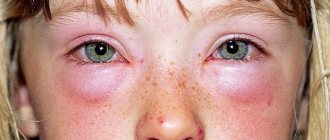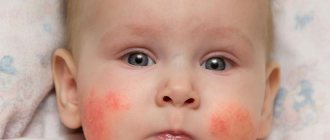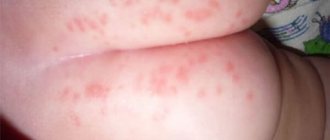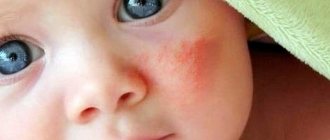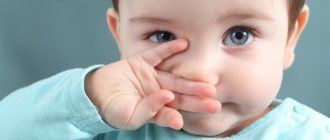General information
Cold allergy is a form of contact type allergic reaction.
When the ambient temperature drops, the child develops symptoms of urticaria, accompanied by significant discomfort.
Even minor exposure to cold (for example, drinking ice cream, a chilled drink, or being outside in windy weather) can trigger an allergy. The main reason for this reaction of the body is the characteristics of the immune system .
Can a child be allergic to cold?
Cold allergies can occur regardless of the patient's age category. A negative reaction occurs even in infants.
In terms of symptoms, this pathology is similar to dermatological diseases .
This nuance makes it difficult to diagnose this type of allergy and creates problems in choosing a course of treatment. Symptoms of an allergic reaction may be minimal or cause significant discomfort to the baby.
Preventive measures
After eliminating the signs of cold urticaria and the factors that provoked a strong reaction, it is important to prevent relapses. You will have to give up some familiar things, pay more attention to organizing walks in frosty weather, but the child’s health depends on the parents’ patience.
Basic Rules:
- protect your face and hands from contact with frosty air, wind, and apply protective agents to your skin before going for a walk;
- walk outside if the thermometer does not drop too low;
- before going outside, open the window for 5 minutes, stand at the window for a while with the child dressed, so that the skin gets used to the cool air;
- lubricate lips with hypoallergenic hygienic lipstick to prevent chapping and peeling;
- Carefully care for the skin, avoid products that irritate the delicate epidermis. Delicate face and body care formulations reduce the risk of irritation;
- teach your son or daughter to drink warm drinks or liquids at room temperature. If you are prone to allergies, both cold and hot drinks are harmful;
- wash with boiled water: increased levels of chlorine exacerbate negative reactions;
- It is imperative to carry out hardening, be careful, avoid the harsh effects of cold water and air;
- from autumn to spring, give vitamin complexes to support the body. In summer, the child should receive vitamins from fresh vegetables and fruits.
If an allergy to cold occurs, parents should promptly seek medical help and protect the child from negative factors. Competent therapy and preventive measures prevent the transition of chronic disease.
What is cold allergy and how to deal with it? Useful information in the following video:
What exactly is an allergen?
Cold is not a potential allergen, but in the presence of certain characteristics of the child’s body, a powerful release of histamine into the blood .
This reaction can be provoked by wind, snow, frost and other unfavorable weather conditions that occur with a seasonal drop in temperature.
As a result of exposure to cold, the baby develops symptoms typical of other forms of allergies (rash, itching, swelling, etc.).
Features of allergies to cold in children:
- Even a slight drop in air temperature or other options for the effects of cold on the body (wind, frost, ice cream, washing hands with cold water, etc.) can provoke an allergic reaction
- Repeated exposure to low temperatures on the child’s body provokes the persistence of existing symptoms for a long time and a significant increase in the degree of its localization.
What is the danger of cold allergies if left untreated?
One can understand the reluctance of parents to visit a doctor, since treatment for allergies is always very long, slow and intensive. But nevertheless, it is necessary to avoid complications in the present and in the future.
What happens to the skin if left untreated? Allergy to frost in children always leads to skin manifestations. As a result of scratching, the affected area can easily become infected, which requires the use of antibiotics, which in turn undermine the immune system. This is a vicious circle, because decreased immunity contributes to the development of allergies.
During allergic reactions and inflammation, toxins are formed, the potential for the development of dermatitis arises, and this pathology can accompany a person for life. Chronic dermatitis in adolescents often causes asthma. Therefore, it is always necessary to treat allergies regardless of your desire, especially since very good results are achieved with proper treatment.
Causes
The main cause of allergies to cold is a disruption of the immune system of the child's body . Various internal and external factors can provoke a decrease in protective functions.
Malfunctions of the immune system can occur due to congenital diseases, chronic inflammatory processes, regular hypothermia of the child, as well as prolonged or uncontrolled use of certain medications. In most cases, it is not possible to diagnose the exact cause
The following factors can cause cold allergies in children:
- Genetic predisposition (the body’s negative reaction to cold can be inherited).
- Weakening of the child’s immunity under the influence of progressive diseases or long-term use of potent medications.
- Tendency to colds or the presence of hepatitis (the presence of chronic diseases in a child increases the risk of developing allergies).
- Regular hypothermia of the child (contact with cold water, wearing clothes that do not correspond to weather conditions, etc.).
- Tendency to skin diseases (allergy to cold can become a complication of some pathologies of this type).
- Low level of stress resistance (if the child’s mental sensitivity is excessive, the risk of allergies to low temperatures increases).
What is a cold allergy?
The name of the phenomenon indicates the pathological reaction of the body to low temperatures. Not so long ago, medicine rejected the existence of a diagnosis, since there was no allergen as such that provoked the condition. However, in recent years the number of people with increased sensitivity to cold has increased sharply. When exposed to low temperatures, their body releases large amounts of histamine (a mediator of immediate allergic reactions). It is this moment that is responsible for the occurrence of manifestations inherent in ordinary allergies.
Cross shape
Cold allergies can develop in cross form.
A negative reaction of the child’s body will manifest itself not only to low temperatures, but also to certain hygiene products, chemicals, and specific types of fabrics.
, the risk of developing other forms of allergies, where irritants are food, animal hair, medications and other types of potential allergens, is not excluded
To treat or not to treat?
A cold allergy can disappear as suddenly as it appeared: it will torment you for several weeks, and then leave you alone for the next year. But more often it happens differently: its manifestations gain strength, and it attacks not only in winter, but even in the middle of summer: it is enough to swim in cool water or eat ice cream on a hot day. Of course, itching, runny nose, tears from the eyes are temporary, and this can be survived, but it is better to save the child from such troubles.
In addition, cold allergies can cause bronchospasm, and this is not something to joke about. Some experts believe that it can even provoke the development of bronchial asthma. So the verdict is clear: treat, period!
But how? If there is no allergen provocateur, then antihistamines are powerless? But no.
- If the doctor has no doubt that this is a cold allergy, antihistamine therapy is the best option. But you cannot select the drug yourself. It should be prescribed in a dosage appropriate to the child’s age and other indications. The course will be quite long. You need to take medications before going out into the cold.
- Acupuncture has a good effect. Several courses are prescribed for 10 days with breaks.
- Drugs that improve peripheral circulation can also be used.
- It is useful to take a course of vitamins A, C, E, PP. Duration of treatment is at least two weeks.
Symptoms and signs
How does cold allergy manifest in a child? Photo:
The symptoms of cold allergy have some peculiarities .
Signs of a child’s body’s negative reaction to low temperatures may appear immediately or some time after exposure to the irritant.
The intensity of symptoms depends on the individual health characteristics of the baby. Some patients experience redness of the skin, while others experience severe rashes combined with a deterioration in their general condition and pain.
Symptoms of an allergy to cold include the following:
- the appearance of a skin rash in combination with signs of chapping of the face;
- swelling of the skin, accompanied by pain;
- itching and burning of the skin;
- general weak condition of the body;
- rapid breathing;
- excessive peeling of the skin;
- a feeling of tickling and burning in the nasopharynx;
- spread of the rash to other parts of the body;
- signs of conjunctivitis;
- diarrhea, nausea and vomiting (rare symptoms);
- dry mucous membranes;
- intense sneezing and a feeling of nasal congestion;
- signs of respiratory diseases.
Recommendations for parents
If your child suffers from cold allergies, then this circumstance must always be remembered. To minimize the risk of exacerbation of the disease, eliminate or at least minimize the effect of the allergen on the body. Among the main recommendations:
- Do everything you can to keep your immune system normal.
- Take vitamin supplements in spring and summer.
- Do not allow your child to become hypothermic or overheated.
- Monitor your child’s diet: it is necessary to exclude fatty, fried, sweets, and citrus fruits from his diet.
- Try to reduce the time your child spends outside during frosts.
- Make sure that all parts of your body are covered when walking in cold weather.
- An hour before the walk, it is recommended to treat the skin with a protective cream.
- Give your child a warm drink just before leaving.
Many doctors recommend using Doromarin to treat cold allergies in a child. These are vitamins for children that can significantly increase the body's immune capabilities. The complex contains exclusively natural ingredients. The basis is the Far Eastern kelp angustataangustata. It fills the body with a sufficient amount of vitamin components.
Of particular importance for the skin is iodine, which protects it from spasms. A complex of micro- and macroelements also has a positive effect on the dermis. They can significantly increase immune abilities, due to which the body better tolerates cold exposure.
Cold allergy is a serious disease that requires proper attention. If its signs appear in children, be sure to visit a doctor who will select a comprehensive treatment. You should not ignore the manifestations of such a reaction from the body.
Why is cold intolerance dangerous?
The consequences of an allergy to cold can pose a threat to a child's life.
The degree of risk depends on the intensity of the symptoms of the disease.
a child’s negative reaction
Causes for concern are the occurrence of laryngeal edema, extensive localization of rashes on the skin and the manifestation of signs of allergy to a slight drop in temperature. In case of anaphylactic shock, a small patient needs urgent medical attention .
Possible complications
Children exhibit more severe symptoms of the disease than adults. Cold allergies pose a threat to the life of a child if accompanied by swelling of the larynx.
Complications:
- Development of asthma.
- Tissue swelling. The extreme degree is swelling of the larynx, as a result of which a person begins to choke.
- Sudden cardiovascular failure and loss of consciousness.
- Bronchospatic reflex. Swelling of the larynx, suffocation, decreased blood pressure.
- Anaphylactic shock. Sharp pain at the site of the rash, accompanied by collapse and bronchospasm. Immediate medical attention is required as this condition is fatal.
Diagnostics and tests
In some cases, diagnosing cold allergies can be difficult due to the clinical picture of the pathology.
The most effective method for identifying a child’s negative reaction to cold is a provocative test.
The doctor applies a small ice cube to the forearm of a small patient. The occurrence of a rash, swelling or redness of the skin indicates that the child is allergic to cold.
procedures can be used :
- determination of the level of immunoglobulins in the blood;
- identifying the threshold of sensitivity of the skin to different temperatures;
- General and biochemical blood test.
Do I need to treat and how?
What should parents do? Allergy to cold requires symptomatic treatment .
The course of therapy is prescribed to the child individually based on the clinical picture of his health condition.
to completely eliminate the negative reaction of a child’s body to a drop in temperature.
The goal of therapy in this case is not only to eliminate the symptoms that have arisen, but also to reduce the risk of its reoccurrence. Treatment of the pathology is complicated by the inability to completely eliminate the irritant - cold.
Drugs
The list of drugs for the treatment of cold allergies is selected individually. Medications used may include antihistamines, antivirals, and immunomodulators .
Self-medication if a child has a pathology is not recommended.
The cause of allergies may be a critically low level of immunity. This condition requires mandatory correction with special medications .
The following types of drugs can be used to treat allergies to cold :
- antihistamines (Fenistil, Erius, Zyrtec);
- sorbents and probiotics (Enterosgel, Bifidumbacterin);
- means for accelerating the process of skin regeneration (Solcoseryl, Bepanten);
- drugs from the corticosteroid group (Flucinar, Advantan);
- vitamin complexes (selected according to the age of the child).
Folk remedies
Traditional medicine for cold allergies is used to increase the protective functions of the child’s body and reduce the sensitivity of the skin to low temperatures.
When choosing recipes, it is important to take into account the child’s health characteristics.
If you are prone to allergies, some foods may provoke an additional negative reaction. If a folk remedy causes a deterioration in the baby’s condition, its further use should be abandoned .
Examples of folk remedies against cold allergies:
- Badger fat (the product is used to lubricate the child’s skin before walking in bad weather; before using the fat, it is important to exclude an allergic reaction to it; this method of protection should not be used too often; it can be used in case of emergency).
- Carrot and beet juice (the use of such drinks has a beneficial effect on the child’s immune system).
- Decoctions to strengthen the immune system (decoctions made from pine cones, chamomile, string or calendula have the ability to reduce allergy symptoms; products are prepared using the traditional method of brewing with boiling water; the child should take decoctions regularly in small portions).
Treatment
An allergen such as cold cannot be eliminated, so treatment is prescribed exclusively symptomatic. Doctors highlight a group of measures:
- Before going outside, the skin of the child’s neck, face and hands is lubricated with baby cream. Instead of cream, badger fat can be used, which has a positive effect on the skin. Apply 25 minutes before walking. Hygienic lipstick is applied to the lips.
- To maintain immunity and reduce the manifestations of “cold urticaria”, it is recommended to take herbal infusions. The best choice seems to be a collection of tricolor violet, burdock root and walnut leaves. They are mixed in equal proportions. To prepare the drink, you need a few tablespoons of the mixture and a glass of boiling water. Give the child 50 ml 3 times a day.
- To relieve skin redness and combat peeling, products with panthenol or rubbing with a decoction of pine cones are prescribed. Four cones are ground in a meat grinder and boiled for half an hour in a liter of water. Wipe the child's skin every day in the evening until symptoms disappear.
Cold-stressed skin of a child should be protected from contact with water containing chlorine. You should also avoid hygiene products that dry out your skin: foams, soaps, shower gels and shampoos.
- A mandatory part of treatment is taking antihistamines: Centrin, Loratodin, Suprastin or Diazolin. Only a doctor prescribes the medication, since each individual case requires a special dosage and duration of use. If a reaction to cold is observed in an infant, doctors recommend the safest antihistamines - Fenistil (used from one month) and Zertec (allowed for children from six months).
- In cases of severe allergic rhinitis, vasoconstrictor drops in the nose cannot be avoided. The composition must contain antihistamines.
- For children with an atypical reaction to low temperatures, special nutrition is recommended. Salty, spicy and smoked foods and fast food are excluded. The diet should consist of bran, fruits, vegetables and fiber-rich foods.
Komarovsky's opinion
Dr. Komarovsky advises parents to follow several important rules that will help reduce the symptoms of cold allergies in their children. don’t have to try to spend less time outside in winter or give up walking in bad weather.
To protect your baby's skin, you can use warmer mittens, scarves or hoods with fur trims.
Additionally, special attention should be paid to the child’s immune system.
Based on the advice of Dr. Komarovsky, the following conclusions :
- The child’s immunity must be strengthened from a very early age.
- To increase the protective functions of the child’s body, it is better to use natural means (food, regular walks in the fresh air, an active lifestyle, etc.).
- If an allergy to cold is detected, you should not try to completely eliminate exposure to low temperatures (for example, significantly limit walks in winter); it is enough to strengthen measures to protect the child’s skin.


